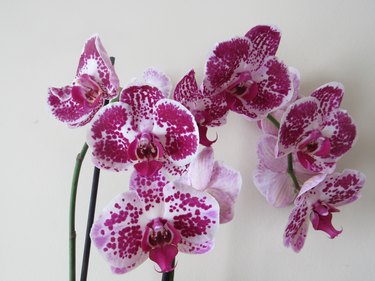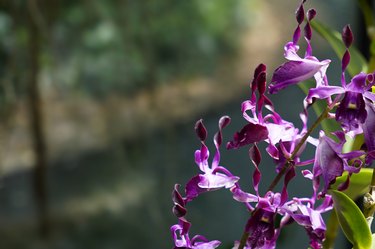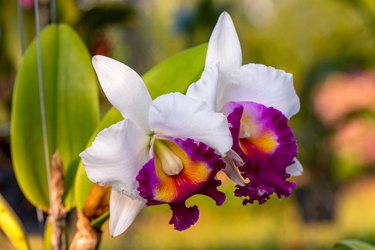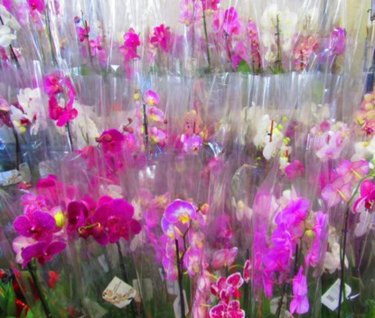
Orchids have a snooty reputation as the prima donnas of the potted plant world, but they are exceptionally popular gifts, thanks to their beautiful blossoms that look like dream butterflies. And unlike other houseplants, orchids can hold their blooms for months on end. They can also rebloom the following year if you do what it takes to keep them alive.
The key to keeping an orchid houseplant alive is understanding their cultural needs, which differ significantly from those of other houseplants. This is complicated by the fact that there are literally thousands of species of orchids, some with widely differing care requirements. But the most popular houseplant varieties (Phalaenopsis, Cattleya, Dendrobium, and Oncidium) all thrive in a shredded bark growing medium; bright, indirect light; and moderate to infrequent watering.
Video of the Day
Video of the Day
Need more details? Read on to learn about the steps you need to take to keep that Valentine's Day orchid alive.
Meet the Orchid
Most of us have been presented with a potted orchid at some point in our life. It's the most common gifted houseplant and a popular choice for Valentine's Day. Moth orchids (Phalaeopsis) are the most common and are even sold in grocery stores, but it's not hard to find cane and corsage orchids either. Any orchid makes a thoughtful gift.
But unfortunately for the orchids, people who receive them as a gift often treat them like cut flowers. They display them until the blossoms die and then toss them. In fact, orchids that are properly cared for can live for years and even decades, blooming again and again over time. The required care is not very difficult.

Common Types of Orchids
About 30,000 species of orchids live in nature, and there are even more registered hybrids. While the care requirements for some of the more exotic varieties may differ widely, the most common varieties require the same basic cultural care. These include moth orchids, cane orchids, and corsage orchids.
Moth Orchids (Phalaeopsis)
If you are buying** an orchid in the grocery store or hardware store, it's very likely to be a moth orchid. These have white or purple/pink-hued blossoms topping a tall, slender stalk that emerges from a whorl of thick leaves. The blossoms are round with a defined lip.
**

Cane Orchids (Dendrobium)
Does your orchid have narrow green leaves and lots of small blossoms appearing on short stalks off thicker canes? If so, it's almost certainly a cane orchid. The flowers are generally either white or purple.
Corsage Orchids (Cattleya)
Known as the "queen of the orchids," the corsage orchid offers fragrant and incredibly showy blossoms in bright, bold tones. There are many types of cattleya orchids, with some blooming all along the lengths of their stems and others only at the top. Even the fragrance differs between types, with some smelling like vanilla and others smelling sweet. They are the favorite for prom corsages, which explains their common name.
Caring for Orchids
Since the moth orchid is the number one orchid that is most commonly given as a gift in the U.S., it makes sense to describe its care requirements first. But we'll tell you if cane or corsage orchids have different needs.
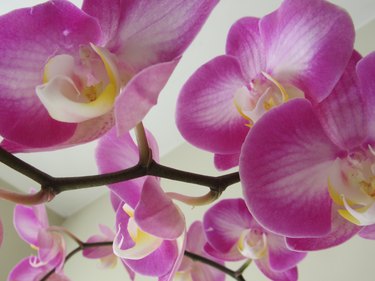
Temperature
Moth orchids are native to hot, humid rain forests. Incidentally, so are cane and corsage orchids. That means all of these orchids grow best if you keep your home warm and humid. For happy orchids, keep your home between 60 and 80°F during the day and 50 to 70°F at night. Cane orchids prefer temperatures of at least 65°F during the day.
Humidity
While human-preferred temperatures generally match orchid preferences, that isn't the case for humidity. Most of us do not keep our home at humidity levels between 40 and 60%, unless you happen to live in a foggy city like San Francisco.
You can still help your orchids by sitting them on a pebble tray with water in it or by bringing in a small humidifier. It also works to group houseplants together since that increases humidity too.
Corsage orchids require a higher humidity level of up to 70%.
Growing Medium
Don't even consider using regular potting soil for an orchid. Remember that many orchids are air plants in the wild, growing on trees or rocks and getting their nutrients from rain and air. Heavy soil will cause their roots to rot.
For moth, cane, and corsage orchids, drainage is more important than nutrient content when it comes to growing medium. Use a light, airy product made specially for orchids, often of chopped bark.
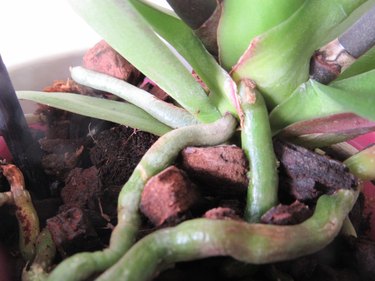
Sun Exposure
Think of the dappled sun that warms orchids growing on trees in the rain forest. That's the ideal, and you can meet it in a home environment by siting your orchids in a spot with bright, indirect sun. Direct sun is very likely to burn orchid leaves, but an east- or south-facing window will work well.
Generally aim to provide at least six hours of bright, indirect light per day. For corsage orchids, it's best to diffuse bright light with a sheer curtain.
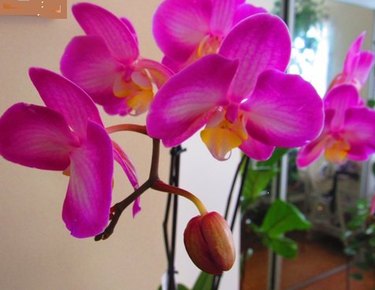
Water
Orchids will not live long if their roots are trapped for any length of time in a wet growing medium. To prevent this, you need to use appropriately light growing medium and allow that medium to dry out completely before watering again.
During the growing season, this will usually mean watering once every week or 10 days. Corsage orchids prefer to be watered when the soil is somewhat dried out but not totally dry. In the dormant season, you can drop watering to twice a month and reduce the amount offered each time.
It is best to give your orchid rainwater or distilled water rather than tap water. The water should never be icy cold but rather tepid.
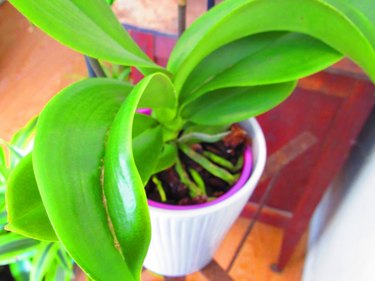
Fertilizer
Just like you can buy orchid-specific growing medium, you can also buy fertilizer manufactured specially for orchids. Use this fertilizer according to package directions. Reduce or stop fertilizer use while the orchid is dormant after blooming.
Whatever happens, don't overdo it. Err on the side of too little rather than too much. Too much fertilizer encourages foliage growth at the expense of flower production. It can also burn the roots.
Pruning
Get out those garden scissors when a flower is fading. Snip off faded flowers regularly and dead leaves and stems as well. The plant will then be able to give 100% of its energy to growth, including new blossoms.
Help Your Orchid to Bloom Again
We've suggested that you shouldn't toss your orchid after it blooms. But that's only tempting if the plant is likely to flower again. So, how can you get it to rebloom?
An orchid plant should flower every year. Different types of orchids have different flowering cycles. Many typically rebloom within six to nine months after the first bloom, but once a year is a minimum. The blooms can last for two, three, or four months.
The best way to ensure a rebloom is to provide great cultural care as described above. But some species, including moth orchids, can be helped along by exposing the potted plant to three or so nights of lower temperatures.
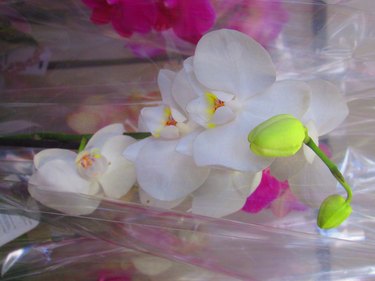
Time to Repot?
You don't have to repot your plant every year after it has flowered. But if it is time to repot, wait until the blooming is over.
What are the signs that your orchid needs repotting? Look for roots that grow out of the pot. That's a sign that repotting is in the cards. Another sign is when the growing medium has broken down.
When it is time to repot, remove the orchid's container. If it seems tight inside, wet down the medium first. When the roots are exposed, take a close look at them. If you see roots that are broken, wounded, or dead, clip them off.
Select a slightly larger container, set the orchid in it, and then add fresh growing material around the roots. If necessary, stake up the plant until the roots grow into the new medium and anchor the orchid.
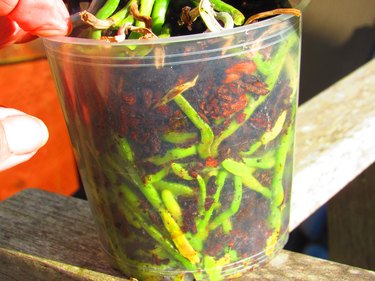
Problems With Your Orchids
Some houseplants are magnets for insect pests. Orchids, however, are not among them and generally don't have major pest problems. You may find common houseplant pests on them, however, like aphids, fungus gnats, spider mites, and scale. Most of these can be washed off by a jet of water.
On the other hand, if you don't provide the plant with appropriate cultural care, you are likely to see problems. These can include:
- Wrinkled foliage: This is a result of insufficient water or unhealthy roots.
- Yellowing leaves: These result from overwatering and can be a sign that root rot has already set in.
- Discolored flowering stems: If stems turn yellow or brown, the cause can be too much water, too much sun, too little nutrients, or fungal issues.
- Wilting leaves: Drooping foliage can be the result of too little water or too little sunlight.
- Buds drop before blooming: This is caused by stress. It could be too much water or too little water, insufficient humidity, or placement near a chilly air conditioner or a heating unit.
